September is Suicide Prevention Month—Here are some resources from NAMI:
https://www.nami.org/About-Mental-Illness/Common-with-Mental-Illness/Risk-of-Suicide?mkt_tok=eyJpIjoiWW1JeE9XUXhNV1JrTURRNSIsInQiOiJEZVVcL0w0S3VGa0txY2p4Rms0WEFDbXA5V0t4Y05qSU50MWJDN0hWaEZHbWR6ZWYxcmg4ZFpYMmFVQjdWRElMUjRjNXJOcEIzMUV1bXBvbEs0UUJOc0EyUGRMdW0xYUpyOXpaNDJ6TUp0dzc3U0J3akJMRWlQc1V2b1QxdkQ2SWUifQ%3D%
If you or someone you know is in an emergency, call The National Suicide Prevention Lifeline at 800-273-TALK (8255) or call 911 immediately.
It can be frightening if someone you love talks about suicidal thoughts. It can be even more frightening if you find yourself thinking about dying
or giving up on life. Not taking these kinds of thoughts seriously can have devastating outcomes, as suicide is a permanent solution to (often)
temporary problems.
According to the CDC, suicide rates have increased by 30% since 1999. Nearly 45,000
lives were lost to suicide in 2016 alone. Comments or thoughts about suicide — also known as suicidal ideation — can begin small
like, “I wish I wasn’t here” or “Nothing matters.” But over time, they can become more explicit and dangerous.
Warning Signs
Here are a few other warning signs of suicide:
- Increased alcohol and drug use
- Aggressive behavior
- Withdrawal from friends, family and community
- Dramatic mood swings
- Impulsive or reckless behavior
Suicidal behaviors are a psychiatric emergency. If you or a loved one starts to take any of these steps, seek immediate help from a health
care provider or call 911:
- Collecting and saving pills or buying a weapon
- Giving away possessions
- Tying up loose ends, like organizing personal papers or paying off debts
- Saying goodbye to friends and family
If you are unsure, a licensed mental health professional can help assess.
Risk Factors
Research has found that 46% of people who die by suicide had a known mental health condition.
Several other things may put a person at risk of suicide, including:
- A family history of suicide
- Substance use. Drugs can create mental highs and lows that worsen suicidal thoughts.
- Intoxication. More than 1 in 3 people who die from suicide
are under the influence of alcohol at the time of death. - Access to firearms
- A serious or chronic medical illness
- Gender. Although more women than men attempt suicide, men are nearly 4x more likely to die by suicide.
- A history of trauma or abuse
- Prolonged stress
- A recent tragedy or loss
Support in a Crisis
When a suicide-related crisis occurs, friends and family are often caught off-guard, unprepared and unsure of what to do. The behaviors of a person
experiencing a crisis can be unpredictable, changing dramatically without warning.
There are a few ways to approach a suicide-crisis:
- Talk openly and honestly. Don’t be afraid to ask questions like: “Do you have a plan for how you would kill yourself?”
- Remove means such as guns, knives or stockpiled pills
- Calmly ask simple and direct questions, like “Can I help you call your psychiatrist?”
- If there are multiple people around, have one person speak at a time
- Express support and concern
- Don’t argue, threaten or raise your voice
- Don’t debate whether suicide is right or wrong
- If you’re nervous, try not to fidget or pace
- Be patient
Like any other health emergency, it’s important to address a mental health crisis like suicide quickly and effectively. Unlike other health emergencies,
mental health crises don’t have instructions or resources on how to help or what to expect (like the Heimlich Maneuver or CPR). That’s why
NAMI created Navigating a Mental Health Crisis: A NAMI Resource Guide for Those Experiencing a Mental Health Emergency,
so people experiencing mental health emergencies and their loved ones can have the answers and information they need when they need it.
If your friend or family member struggles with suicidal ideation day-to-day, let them know that they can talk with you about what they’re
going through. Make sure that you adopt an open and compassionate mindset when they’re talking. Instead of “arguing” or trying to disprove
any negative statements they make (“Your life isn’t that bad!”), try active listening techniques such as reflecting their feelings and summarizing
their thoughts. This can help your loved one feel heard and validated.
Let them know that mental health professionals are trained to help people understand their feelings and improve mental wellness and resiliency.
Psychotherapy, like cognitive behavioral therapy and dialectical behavior
therapy, can help a person with thoughts of suicide recognize ineffective patterns of thinking and behavior, validate their feelings and learn
coping skills. Suicidal thoughts are a symptom, just like any other — they can be treated, and they can improve over time.
Suicide is not the answer. There is hope.
08.2019



